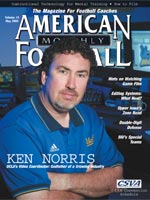Article CategoriesAFM Magazine
|
Zone ReadUpper Iowa University\'s© More from this issue The
theory behind the Zone Read Play: The Zone Play, whether it is inside or outside, is a front side gap scheme. The
advantage of the zone blocking scheme, compared to ma....The full article can only be seen by subscribers.
|
|
|||||||
| HOME |
MAGAZINE |
SUBSCRIBE | ONLINE COLUMNISTS | COACHING VIDEOS |
Copyright 2025, AmericanFootballMonthly.com
All Rights Reserved





